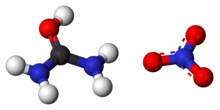Urea nitrate

| |

| |
| Identifiers | |
|---|---|
3D model (JSmol)
|
|
| ChemSpider | |
PubChem CID
|
|
| UNII | |
| |
| |
| Properties | |
| CH5N3O4 | |
| Molar mass | 123.068 g·mol−1 |
| Density | 1.67±0.011 g/cm3[1] |
| Melting point | 157–159 °C (315–318 °F; 430–432 K) |
| 167.2±0.5 mg/mL[1] | |
| Solubility in Ethanol | 14.2±0.1 mg/mL[1] |
| Solubility in Acetone | 10.4±0.2 mg/mL[1] |
| Solubility in Methanol | 54.8±0.9 mg/mL[1] |
| Explosive data | |
| Shock sensitivity | Low |
| Friction sensitivity | Low |
| Detonation velocity | 4700 m/s |
| Hazards | |
| GHS labelling: | |
  
| |
| Danger | |
| H201, H271, H301, H304, H314, H332 | |
| P220, P233, P250, P260, P305+P351+P338 | |
| NFPA 704 (fire diamond) | <imagemap>
File:NFPA 704.svg|80px|alt=NFPA 704 four-colored diamond poly 150 150 300 300 150 450 0 300 Health 2: Intense or continued but not chronic exposure could cause temporary incapacitation or possible residual injury. E.g. chloroform poly 300 0 450 150 300 300 150 150 Flammability 1: Must be pre-heated before ignition can occur. Flash point over 93 °C (200 °F). E.g. canola oil poly 450 150 600 300 450 450 300 300 Instability 3: Capable of detonation or explosive decomposition but requires a strong initiating source, must be heated under confinement before initiation, reacts explosively with water, or will detonate if severely shocked. E.g. hydrogen peroxide poly 300 300 450 450 300 600 150 450 Special hazards (white): no code desc none </imagemap> |
Except where otherwise noted, data are given for materials in their standard state (at 25 °C [77 °F], 100 kPa).
| |

Urea nitrate is a fertilizer-based high explosive that has been used in improvised explosive devices in Afghanistan, Pakistan, Iraq, and various terrorist acts elsewhere in the world such as in the 1993 World Trade Center bombings.[2] It has a destructive power similar to better-known ammonium nitrate explosives, with a velocity of detonation between 3,400 m/s (11,155 ft/s) and 4,700 m/s (15,420 ft/s).[3] It has chemical formula of CH5N3O4 or (NH2)2COHNO3.
Urea nitrate is produced in one step by reaction of urea with nitric acid. This is an exothermic reaction, so steps must be taken to control the temperature.
It was discovered in 1797 by William Cruickshank,[4] inventor of the Chloralkali process.
Urea nitrate explosions may be initiated using a blasting cap.[3]
Chemistry
Urea contains a carbonyl group. The more electronegative oxygen atom pulls electrons away from the carbon atom, forming a polar bond with greater electron density around the oxygen atom, giving it a partial negative charge. In a simplistic sense, nitric acid dissociates in aqueous solution into protons (hydrogen cations) and nitrate anions. The electrophilic proton contributed by the acid is attracted to the negatively charged oxygen atom on the urea molecule and the two form a covalent bond. The formed O-H bond is stabilized into a hydroxyl group when the oxygen abstracts an electron pair away from the central carbon atom, which leads to bond resonance between it and the two amino groups. As such, the urea cation can be thought of as a amidinium species. Paired with the spectator nitrate counteranion, it forms urea nitrate.
- (NH2)2CO (aq) + HNO3 (aq) → [(NH2)2COH]+[NO3]− (s)
The compound is favored by many amateur explosive enthusiasts as a principal explosive for use in larger charges. In this role it acts as a substitute for ammonium nitrate based explosives. This is due to the ease of acquiring the materials necessary to synthesize it, and its greater sensitivity to initiation compared to ammonium nitrate based explosives.
References
- ^ 1.0 1.1 1.2 1.3 1.4 Oxley, Jimmie C.; Smith, James L.; Vadlamannati, Sravanthi; Brown, Austin C.; Zhang, Guang; Swanson, Devon S.; Canino, Jonathan (2013). "Synthesis and Characterization of Urea Nitrate and Nitrourea". Propellants, Explosives, Pyrotechnics. 38 (3): 335–344. doi:10.1002/prep.201200178.
- ^ Aaron Rowe (18 September 2007). "Chem Lab: Spray-On Test for Improvised Explosives". Wired.
- ^ 3.0 3.1 "Explosives - ANFO (Ammonium Nitrate - Fuel Oil)". GlobalSecurity.org.
- ^ Rosenfeld, Louis (1999). Four Centuries of Clinical Chemistry. CRC Press. ISBN 978-90-5699-645-1.
Further reading
- Almog J, Burda G, Shloosh Y, Abramovich-Bar S, Wolf E, Tamiri T (November 2007). "Recovery and detection of urea nitrate in traces". J. Forensic Sci. 52 (6): 1284–90. doi:10.1111/j.1556-4029.2007.00551.x. PMID 17868267. S2CID 10228717.
- Mr.X (July 2008). "Improvised Urea Nitrate". Aware EZine Gamma. Archived from the original on 2008-09-20. Retrieved 2008-11-11.
External links
 Media related to Urea nitrate at Wikimedia Commons
Media related to Urea nitrate at Wikimedia Commons